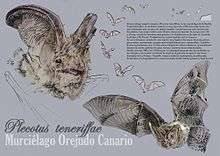Canary big-eared bat
The Canary big-eared bat (Plecotus teneriffae), also known as the Tenerife long-eared bat is a species of vesper bat endemic to the Canary Islands.[2] According to the IUCN, it is vulnerable to the risk of extinction.[1] The species is primarily found in woodland habitat at elevations between 100 and 2300 m.[1] It feeds mainly on moths. Roosting sites include caves, lava tubes and abandoned buildings.
| Canary big-eared bat | |
|---|---|
 | |
| Scientific classification | |
| Kingdom: | Animalia |
| Phylum: | Chordata |
| Class: | Mammalia |
| Order: | Chiroptera |
| Family: | Vespertilionidae |
| Genus: | Plecotus |
| Species: | P. teneriffae' |
| Binomial name | |
| Plecotus teneriffae' Barret-Hamilton, 1907 | |
 | |
| Range of the canary big-eared bat | |
Taxonomy and etymology
It was described as a new species in 1907 by British mammalogist Gerald Edwin Hamilton Barrett-Hamilton. He described it based on specimens in the British Museum of Natural History. The holotype had been collected by R. Gomez in April 1887 near the town of La Orotava. "R. Gomez" was likely Ramon Gomez, a local pharmacist who traded in medicines, old coins, and biological specimens from the Canary Islands.[3][4] Its species name "teneriffae" is derived from Tenerife, which is one of the islands of the Canary Islands and the place where the holotype was collected.[5]
Description
When Hamilton described it as a new species, he noted that it was similar in appearance to the brown long-eared bat, Plecotus auritus, but that it had "much larger wings."[5]
Conservation
It is evaluated as vulnerable by the IUCN. It meets the criteria for this designation because its estimated area of occurrence is less than 20,000 km2 (7,700 sq mi), it is found in fewer than five locations, its population is declining, and it is losing habitat. It is threatened by habitat loss due to deforestation, use of pesticides near forest habitat, and loss of roosting sites due to building renovation.[1] The remaining population is estimated to number between 500 and 2000.[1] Only two breeding colonies, one each on La Palma (in the Cuevas de los Murciélagos)[6] and Tenerife, are known; the larger La Palma colony is estimated to have declined by 80% in recent years. It is a protected species under Spanish law and international conventions (the Bonn Convention and Berne Convention).[1]
References
- Juste, Javier & Alcaldé, Juan Tomas (2016). "Plecotus teneriffae". IUCN Red List of Threatened Species. 2016: e.T17602A1424721. doi:10.2305/IUCN.UK.2016-2.RLTS.T17602A1424721.en.
- Simmons, N.B. (2005). "Order Chiroptera". In Wilson, D.E.; Reeder, D.M (eds.). Mammal Species of the World: A Taxonomic and Geographic Reference (3rd ed.). Johns Hopkins University Press. p. 483. ISBN 978-0-8018-8221-0. OCLC 62265494.
- Lockyer, Sir Norman, ed. (1887). Nature. 36. Macmillan Journals Limited. p. 123.
- Samler Brown, A. (1908). Brown's Madeira, Canary Islands, and Azores, a Practical and Complete Guide for the Use of Tourists and Invalids: With Twenty Coloured Maps and Plans and Numerous Sectional and Other Diagrams. Sampson, Low, Marston. p. 35.
- Barrett-Hamilton, G.E.H. (1907). "LXXV.—Description of two new species of Plecotus". The Annals and Magazine of Natural History: Including Zoology, Botany, and Geology. 20 (7): 520–521. doi:10.1080/00222930709487381.
- Domingo Trujillo: Plecotus teneriffae Orejudo canario, 2004:p 258-261
